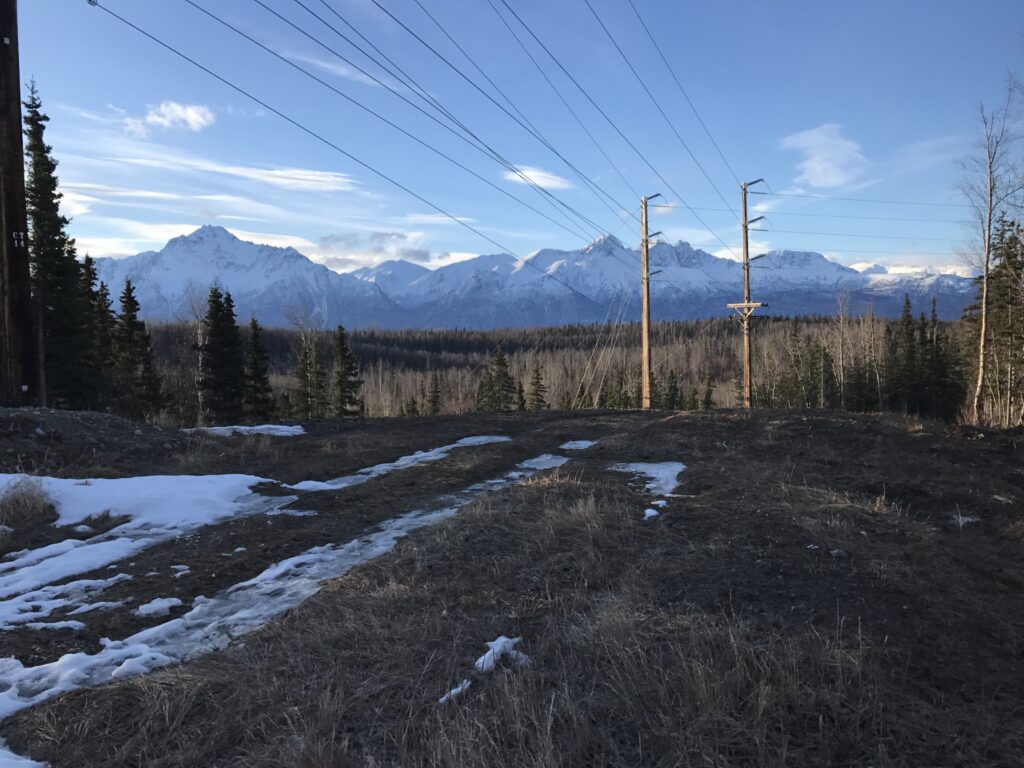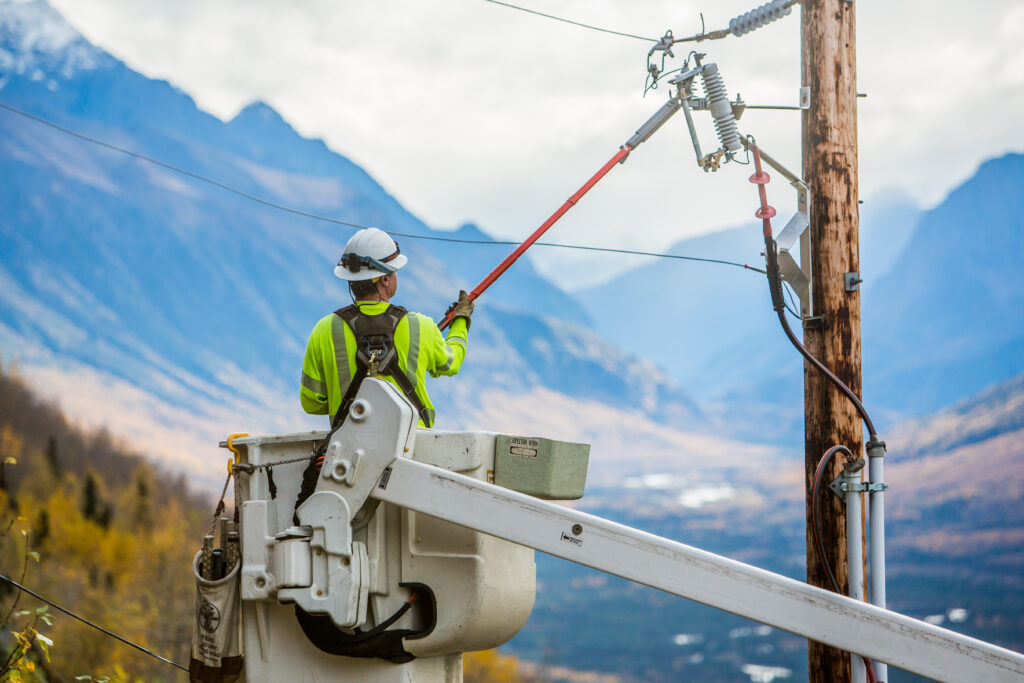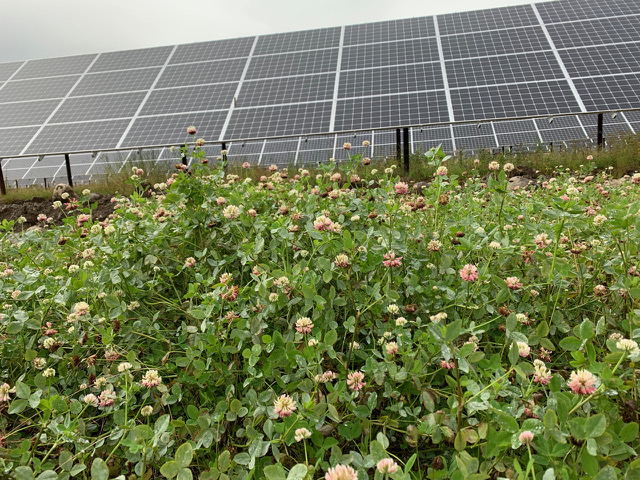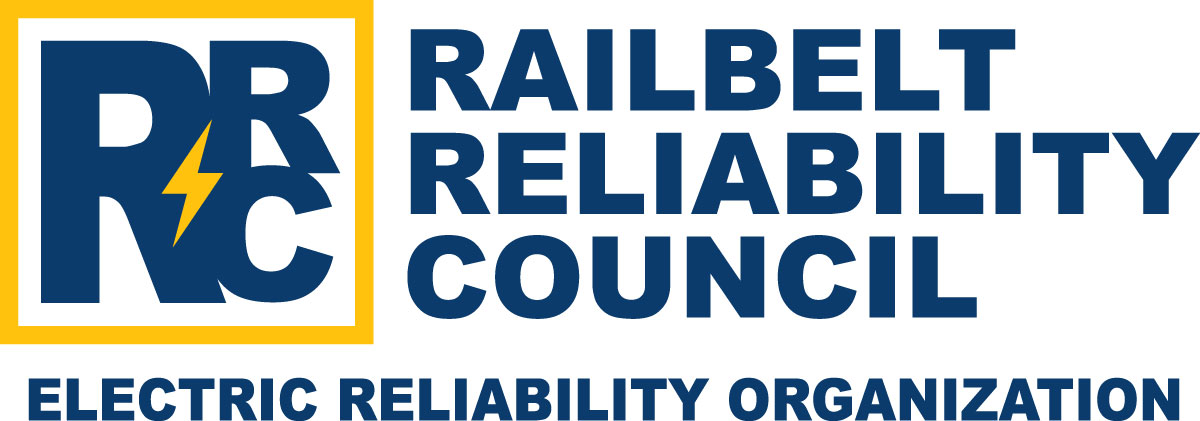Table of Contents: Click to Jump to a Section
HISTORY OF THE RAILBELT GRID
The Railbelt Reliability Council represents the culmination of decades of effort by utilities, stakeholder interests, regulators, and policy makers to increase grid resilience and reduce long-term costs to consumers through enhanced cooperation and connectedness in Alaska’s Railbelt region.
Home to nearly three-fourths of the state’s population, the Railbelt is served by five load-serving electric utilities interconnected across nearly 700 miles of Alaska’s rugged landscape. These utilities generate and distribute power to consumers within their regions – Golden Valley Electric Association in Fairbanks and the Interior; Matanuska Electric Association in Eagle River and the Mat-Su Valley; Chugach Electric Association in Anchorage and the northern Kenai Peninsula; Homer Electric Association throughout the southern Kenai Peninsula; and the Seward Electric System in Seward. Additional generation and transmission services are also provided by the Alaska Energy Authority and independent power producers.
When these utilities were first formed many decades ago, they were isolated from each other. Over time, populations in those service territories have grown closer together. New opportunities and economics have also resulted in interconnecting transmission lines being built to tie them together, the sharing of new generation projects, and ever-greater interconnection and interdependency with one another. Today, each utility maintains a responsibility to ensure its home region has reliable electric power and an increased focus on collaboration for solutions that benefit Alaskans region-wide.
For years, the utilities, grid interests, regulators, and policy makers sought ways for the utilities to work more closely together to plan and develop shared new generation and transmission capacity, and economically optimize power generation and transmission practices across the connected grid. The recurring challenge has been to identify ways for these disparate utilities to reconcile their self-interests and obligations to their own customers with the common-good benefits of new transmission assets, jointly developed generation resources, security-constrained economic dispatch of all generation resources, and similar grid-level optimization and enhancement efforts.
With significant capital investment in new generation and transmission again on the horizon, and with significant opportunities for the grid and ratepayers to benefit from improved connectivity and reliable power transmission across the entire Railbelt, leaders understood the system must be operated in the most effective, efficient way possible to realize the greatest benefit of those new investments.
Click here to jump to the top of the page.

A NEW ERA
Acknowledging that greater cooperation could realize efficiencies and ratepayer benefits, the Legislature in 2014 directed the Regulatory Commission of Alaska (RCA) to investigate and report on means to improve effective and efficient electrical transmission among the utilities. The RCA’s recommendations included the critical need for greater cooperation and coordination among stakeholders and enforceable, consistent reliability standards for grid operations. It became recognized that a top-down mandate would ultimately be necessary to empower utilities to expand their decision-making perspective from local self-interests to recognition and pursuit of grid-wide optimization and benefits. Therefore, following that investigation, the RCA directed the utilities to construct a solution that allowed for grid-optimized decisions.
After the RCA’s report was issued in 2015, significant progress was made toward greater collaboration and cooperation and explored joint operations that incrementally realized the RCA’s recommendations. Major achievements included the purchase of ML&P by CEA that closed in late 2020, and formation of a Tight Power Pool between CEA and MEA as a condition of the CEA-ML&P consolidation as well as a study to investigate the ‘best-fit’ option of a collaborative structure for the Railbelt system by an independent, nationally-recognized expert in the field.
Click here to jump to the top of the page.

THE RAILBELT RELIABILITY COUNCIL (RRC)
In late 2019, the utilities, in consultation with other stakeholders, solidified their support for a reliability organization by signing a memorandum of understanding (MOU) to form the RRC Implementation Committee (IC). This action marked a major milestone for the utilities, other Railbelt entities, and policy makers who had worked for years toward a collaborative organization. Subsequently, the Legislature in 2020 passed legislation to mandate the creation of an electric reliability organization (ERO) to work on reliability, interconnection, and transmission standards and integrated resource planning for the Railbelt. The legislation positioned the RCA to regulate EROs and retain grid oversight, as well as defining an ERO’s structure and operating rules to ensure the public interest is met.
While the legislation was under development in early 2020, the utilities implemented their MOU, organizing the RRC Implementation Committee (RRC IC) and soliciting volunteers from a broad range of stakeholder representatives with an interest in Railbelt reliability and planning to join the RRC IC. The solicited stakeholder groups included the state’s Alaska Energy Authority, consumer advocates, environmental advocates, independent power producers, and unaffiliated representatives. These stakeholders, along with the utilities, became the RRC IC with the mission of organizing and building the RRC organization and eventually applying to the RCA for certification as the Railbelt’s ERO.
The IC began its work in July 2020 and committed from the start to establishing processes and rules reflecting its founding principles – to strive for openness, inclusiveness, and technically strong work product while balancing the diverse interests of its membership. A balanced-interest subcommittee structure was employed to develop policies, processes, and other requirements, and to manage independent, nationally recognized subject matter experts on integrated resource planning, governance, standards development and compliance, budget, organizational structure, and public transparency and involvement. From its inception, the RRC IC required supermajority approval of key actions to ensure robust consensus for the foundational development of the organization. This promoted balance, equity, and collaboration, and over time helped each IC member develop a deeper understanding of the priorities and concerns of other members. This supermajority requirement carried over into the bylaws of the new RRC as a core tool to attain balance among Railbelt interests for key organizational decisions.
While the RRC IC was organizing, the Governor signed the ERO legislation into law in April of 2020, and the RCA began developing implementing regulations that were promulgated in December of 2021. During this time, the RRC IC modified its composition to bifurcate the single consumer representative into small and large consumer representatives, and replaced the two unaffiliated representatives with a single independent representative and a single environmental consumer representative. This modified structure conformed with regulatory requirements for ERO governance and is the current composition of the RRC’s Board of Directors.
On January 31, 2022, the RRC IC voted unanimously to incorporate the RRC as a 501(c)(4) not-for-profit corporation. The first meeting of the incorporated RRC was held on March 14, 2022 to adopt bylaws, policies, and other foundational documents. The voting members of the IC were installed as the RRC’s first directors during this first meeting. A few weeks later, the RRC submitted its application to the RCA for certification as an ERO. Following six months of public hearings and review, the RCA approved the RRC as the Railbelt’s ERO on September 23, 2022.
As of early 2023, the Railbelt Reliability Council is developing its nascent organization. Among the first tasks are achieving RCA approval of an initial tariff and operating rules; hiring a chief executive officer and the technical staff, anticipated by 2024, that will lead development of standards and plans; and setting up basic administrative operations. Once staff is hired, the RRC will transition from organizational development to performing its primary mission work:
- Establishing and enforcing clear, nondiscriminatory rules of operation for all entities connected to the Railbelt network.
- Ensuring advanced planning of large new transmission and generation projects that are consistent with the public interest and coordinated through an integrated system-wide planning process.
- Fostering increased cooperation among the utilities, others connected to the network and consumers to improve reliability, security, and system efficiencies important to the life, health, safety, and economic well-being of Railbelt consumers.
Click here to jump to the top of the page.

RRC GOVERNANCE AND BALANCE
The RRC has a unique board structure designed to bring diverse perspectives together in the public interest. This structure is intended to reflect the broad spectrum of interests that either impact or are impacted by a reliable, robust electric system. The board structure meets strict requirements in RCA regulations that strive to include multiple and diverse stakeholder perspectives and ensure those interests are balanced to accomplish RRC business. Regulations require interests to be assigned different classifications, and balance is demonstrated through a combination of board composition, voting rules, and ensuring directors have sufficient resources to adequately represent their classes, regardless of their individual technical backgrounds.
Ensuring balanced representation in product development and board decisions is a core tenet of Alaska’s first ERO. In creating the framework for an ERO the Legislature required that the board be independent or balanced in order to avoid any one interest from controlling ERO actions. The RRC achieves this balance by composing its board in number and by interest to ensure no one interest has overwhelming power, and by enacting certain Board procedures and voting requirements to make sure each interest is heard and considered in decision-making. Notably, many core RRC Board actions require a supermajority vote of directors, ensuring significant decisions are made only if supported by multiple Railbelt constituencies.
Click here to jump to the top of the page.

RRC BOARD OF DIRECTORS
The RRC has 13 voting director seats and two ex-officio, non-voting seats. The two ex officio seats – assigned to the Regulatory Commission of Alaska and to the Alaska Attorney General’s Office – ensure the RRC’s regulator (RCA) and the state’s regulatory affairs and public advocacy office are part of the board’s work.
The 13 voting director seats are each assigned to a stakeholder class, representing either a power producer stakeholder (utility or independent power producer), a power consumer stakeholder (resident, business, or environmental), or an independent perspective (unaffiliated individual) within the Railbelt. The seats are further designated by more specific characteristics of their stakeholder class, as allowed under ERO regulations. These divisions demarcate interests and are based on, in part, their role in grid operations and their interests in reliability standards and integrated resource planning. See the RRC’s ERO application for more detail. The RRC believes these stakeholder classes inclusively represent generally understood stakeholder groups with interests in Railbelt electric system coordination efforts.
In all, the board includes:
- 4 seats designated to electric utility cooperatives in acknowledgment of the utilities’ vital role in grid operations and planning, with each of the Railbelt’s four electric utilities cooperatives (CEA, MEA, HEA, GVEA) appointing a director for one of the seats to ensure broad regional representation of utility concerns and responsibilities. These utility seats represent both the producer and the consumer stakeholder groups. The RRC’s ERO application provides more information (pp. 29-30) about how this is reflected in the Board balance.
- 1 seat designated to the Railbelt’s single municipal electric utility, with the City of Seward appointing a director for the seat.
- 1 seat designated to a distribution-only power provider, with Doyon Utilities (the only such provider in the Railbelt) appointing the seat director.
- 1 seat designated to the State of Alaska as a power provider and transmission owner that is not a utility, with the Alaska Energy Authority, which owns the state’s Bradley Lake Hydro facility, as well as the transmission lines connecting the southern and northern regions (for example, between Willow and Healy), appointing the seat director.
- 2 seats assigned to independent power producers, in recognition of the increasing number and role of these power providers on the Railbelt grid.
- 1 seat assigned to residential and small commercial power consumers, with a group of up to 15 residential and small commercial power consumers appointing the director.
- 1 seat assigned to large commercial and industrial power consumers, with a group of up to 15 large commercial and industrial power consumers appointing the director.
- 1 seat assigned to consumers with environmental advocacy as their leading policy priority, with a group of such consumers appointing the director.
- 1 seat assigned to an independent person unaffiliated with a grid entity, recruited in a public process and appointed by the RRC board.
In this manner, every director is appointed by an entity or group, as applicable, of the stakeholder class that the director is tasked with representing on the RRC board. Because the board seats represent stakeholder classes, each director is required to have experience with and understand the issues and concerns of their stakeholder class. Providing the appointees meet this requirement and basic qualifications, they are not subject to additional approvals by the RRC once appointed by the entities or groups.
Click here to jump to the top of the page.
